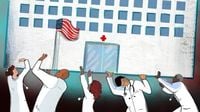For decades, the United States has been a magnet for doctors from around the world, drawing thousands of foreign-trained physicians who fill crucial gaps in the nation’s healthcare system. But a recent surge in visa costs, triggered by a new federal policy, has thrown the future of this vital workforce into doubt—especially in America’s most underserved communities.
As of November 2025, foreign-trained doctors make up nearly a quarter of the U.S. medical workforce. According to NPR, that’s roughly 325,000 physicians—many from India, Pakistan, the Philippines, and increasingly, Nigeria—living and working across the country. In rural hospitals, immigrant doctors sometimes comprise the entire medical staff, stepping into roles that American graduates often overlook for more lucrative or prestigious positions.
But a seismic shift arrived in September 2025, when President Donald Trump issued a proclamation that hiked the cost for hospitals to sponsor a physician’s H-1B visa from about $5,000 to a staggering $100,000 per doctor. As Eram Alam, a historian of science at Harvard and author of The Care of Foreigners: How Immigrant Physicians Changed US Healthcare, told The South China Morning Post, “This is a massive increase.” She added that smaller hospitals, especially those serving rural America, simply cannot absorb the new cost.
Michael Liu, an internal medicine resident at Mass General Brigham in Boston, saw the policy’s impact firsthand. Born and raised in Toronto, Liu came to the U.S. for college and medical school, drawn by the promise of the American Dream and the country’s reputation for research excellence. “You know, in chase of the American Dream, and understanding all the opportunities—that was such a draw for me,” Liu told NPR. But after watching colleagues from Mexico and Costa Rica react tearfully to the sudden uncertainty over their careers, Liu found himself questioning his own future in the U.S. “It feels like my contribution is—just because I was not born in this country—less valued,” he said. “I really hadn’t thought so deeply about going back home before, but definitely it’s been much more top of mind.”
The consequences of the fee hike are rippling through the healthcare system. In some specialties, such as primary care and oncology, foreign-born doctors account for about half of the workforce, according to NPR. Liu’s own research, published in JAMA, estimates that around 11,000 doctors—roughly 1% of the country’s physicians—hold H-1B visas. But those numbers climb dramatically in high-poverty and rural counties, where as many as 40% of physicians are on H-1B visas. “High poverty counties had a four times higher prevalence of H-1B physicians; we also saw that same pattern in rural communities,” Liu explained.
For many hospitals, especially those in less affluent or remote areas, the new cost is simply unmanageable. “Many rely almost entirely on foreign-trained physicians who take up roles that American doctors often leave aside in favor of higher-paying or more prestigious work,” Alam told The South China Morning Post. These immigrant doctors have historically accepted positions in challenging settings, filling gaps in the system that might otherwise go unaddressed. Over time, many have risen to leadership roles and become visible figures in their communities and in the media.
The American Medical Association (AMA) has stepped in, urging the administration to exempt physicians from the new fees. The association notes the crucial role immigrant doctors play in caring for millions of Americans. So far, the Department of Health and Human Services has not responded to requests for comment on recent visa policies and their impact on healthcare workers, according to NPR.
Dr. Julie Gralow, chief medical officer at the American Society of Clinical Oncology, warns that the U.S. is at a “pivotal moment” where decades of progress could be at risk. She told NPR, “Up until this year, it was a dream—a wish!—that you could get a job and you could come to the U.S. And now nobody wants to come.” Gralow points out that other countries—including China, Denmark, Germany, and Australia—are now actively recruiting international talent away from the U.S., offering stable grant funding and state-of-the-art facilities. Even American-born doctors and researchers are being lured abroad. The long-term impact, she says, will be felt by American patients for generations.
This isn’t the first time the U.S. has relied on immigrant physicians to meet its healthcare needs. In 1965, the Hart-Celler Immigration and Nationality Act opened U.S. borders to doctors and other skilled professionals, just as Medicare and Medicaid were dramatically expanding access to healthcare. Eram Alam notes that “overnight, you have 25 million—approximately—people who can now access health care services.” The result was a dramatic influx of talent: by 1975, nearly 45% of all U.S. doctors were immigrants. For decades, the U.S. has attracted more physician talent than it could educate and train itself. “There were more immigrant physicians that were entering the labor force per year than there were U.S. trained physicians that were joining,” Alam told NPR.
However, the U.S.’s longstanding dependence on foreign-trained doctors has come at a cost to their home countries, which often subsidize medical education with taxpayer money. Alam emphasized to The South China Morning Post that this “adds to the strain on health systems abroad and deepens the global shortage.” She argues that the U.S. needs to train enough of its own doctors so it can support medical systems worldwide, rather than depending on immigration to fill domestic gaps.
Despite the fee hike, President Trump has recently signaled some openness to bringing in skilled workers for sensitive fields. When asked by Fox News host Laura Ingraham if his administration would deprioritize the H-1B route, Trump replied, “You do have to bring in talent.” When Ingraham countered, “We have plenty of talent,” Trump responded, “No, you don’t,” adding, “You don’t have certain talents…”
Yet for many foreign-trained doctors, the damage may already be done. Hospitals and universities report that top international medical talent are increasingly reluctant to come to the U.S., citing unstable policies and a diminished sense of welcome. “This is a real pivotal moment right now where decades of progress could be at risk,” Gralow said.
As the U.S. narrows its borders and raises barriers for immigrant physicians, it risks undoing years of leadership in global medicine and science. The effects are not just bureaucratic—they’re deeply personal, affecting the lives and careers of thousands, and the health of millions more. The question now is whether America’s healthcare system can adapt before the damage becomes irreversible.




